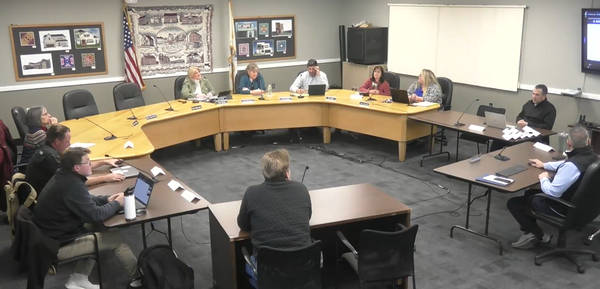
Warrant Article Summary for Burlington September 2025 Town Meeting
A Warrant Article Summary for the September 2025 Town Meeting in Burlington, MA. The meeting begins September 29, 2025 and continues on Wednesdays and Mondays until complete.

A Warrant Article Summary for the September 2025 Town Meeting in Burlington, MA. The meeting begins September 29, 2025 and continues on Wednesdays and Mondays until complete.

A list of each elected and appointed body in the the town with a summary of its responsibilities

Plus, learn about the candidates for this important job

The executive branch of our town's government

The legislative branch of our town's government

Setting the character of our town

From raffles to special discounts, Burlington-area organizations have been working to benefit local residents this season.
While community support is essential to help the most vulnerable members of our community year-round, the holiday season is a common time for businesses and individuals to spread their generosity and support in the form of donations to, or events supporting, local nonprofits. Here are a few ways local businesses have worked to give back locally this winter.
For the 28th year, Burlington Mall hosted the annual Wish Tree to benefit People Helping People, the Burlington non-profit that supports families who need support with food and basic needs. Through the Wish Tree program, Burlington families are able to request items as holiday gifts; these wishes are fulfilled by residents and distributed to families in mid-December.
This year, Joss & Main donated and designed a cluster of Wish Trees, creating space for even more wishes from Burlington children.

Each year, Kadilak Realty Group hosts a party at Grandview Farm where families can meet Santa and pose for a photo. The gathering has grown over the years in both size and activity offerings; this year it brought nearly 400 attendees together for a magic show, cookie decorating, crafts, letters to Santa, and, of course, professional photos with Santa.
Each year, a raffle is held, with ticket sales benefitting local children's nonprofit, WeeCare Burlington. This year, $1,270 was donated to WeeCare.

Since 2021, the Disabled American Veterans (DAV) chapter of Burlington has provided meals to go in honor of Pearl Harbor Day for the staff and residents of Bedford Green, an apartment complex in Bedford that provides supportive housing for veterans ages 55+.
This year, Burlington's DAV chapter distributed 40 meals from Capellini's of Tewksbury, which staff and residents could take home or enjoy together in the Community Room.

Before the chill had settled in the air this fall, The Capital Grille Burlington brought together local business leaders, Burlington Area Chamber of Commerce members, and town officials for a networking evening that also supported a meaningful local cause. Hosted by Managing Partner Adam Mackler at the restaurant’s Wayside Road location, the event raised both funds and awareness for Mission of Deeds, a Reading-based nonprofit that helps individuals and families furnish their homes after experiencing homelessness, domestic violence, or extreme hardship.
Brendan F. Stapleton, owner of Fitness Together and Chairman of the Board of the Burlington Area Chamber of Commerce, highlighted the community spirit embodied by this event. "Supporting Mission of Deeds reflects our Chamber’s commitment to service and reminds us that the strength of our business community is measured by the impact we make on people’s lives.” The event brought in $1,100 for the Mission of Deeds.

The Burlington Area Chamber of Commerce also held its first "Stuff a Shuttle" drive this December, bringing together local businesses and community members to collect food and toys for families in need. Over the course of the drive, donation boxes placed at workplaces and community locations across Burlington, Billerica, Bedford, and Cambridge filled up quickly, ultimately totaling more than 900 pounds of non-perishable food for the Burlington Food Pantry, along with hundreds of new, unwrapped toys for Toys for Tots.
With help from TransAction Associates & Corporate Shuttles, the donations were picked up, loaded onto a shuttle, and delivered directly to People Helping People, Inc. and Toys for Tots, supporting organizations that work year-round with local families facing food insecurity and financial hardship.
Momentum Enterprises, owner of Launch Family Entertainment and MyGym, and Wonderfund of Massachusetts just announced a partnership that will offer discounts to DCF-involved foster children and caregivers in Massachusetts; this includes the Woburn location of Launch and the Burlington MyGym location.
Both business will offer lower rates for birthday parties, while Launch will offer admission discounts and MyGym will offer discounted monthly memberships. These special rates, which will continue into 2026, are a part of an effort to expand access to safe, active, and enriching experiences.
Do you know of a business doing good this holiday or beyond? Let us know at hello@burlington.buzz.
To learn how you can get involved in giving back, or if you need assistance, you can check out our "Where to Give and Get Help" page and visit the tables of Burlington's local nonprofits at the Third Annual Civic Expo on January 14 from 5:00 to 7:00 PM at the Burlington High School cafeteria.
 Burlington BuzzNicci Kadilak
Burlington BuzzNicci Kadilak

Burlington Pop Warner’s Mighty Mites and Junior Pee Wee cheer teams head to Nationals, celebrating hard work, community support, and a historic season.

Veras Connolly joins as a Buzz contributor, designing and creating a new comic every Friday.

Your guide to back-to-school season: schedules, menus, traffic tips, and resources to help families and the whole community start the year strong.

Hive members keep the Buzz thriving.

The site, chosen for its biodiversity, was one of six used for a study of the organisms in soil that support soil fertility and tree growth

Boys’ basketball earned a win over Wakefield, while track and girls’ basketball faced tough tests in an action-packed Monday.

TTS (That's The Spirit) Players is set to open with a new production in early 2026

Burlington basketball swept Melrose, wrestling shined at the Lowell Holidays, and swim saw a state qualifier despite a tough league loss.

"Energy storage is the answer to [uneven production], because it allows us more generally to line up the supply and demand with each other so that they fit really well.”

From tiny fish to tank-busting giants, our oscars taught us the painful difference between captivity and a true habitat.

The high-level, long-range plan is a vision for the future, but governing boards want to see more

Despite freezing weather, Burlington scouts logged 84 hours cleaning five acres of wetlands, demonstrating the principle of "Leave No Trace."

Wrestling cruised past Malden Catholic, girls’ hockey earned their first win of the season, and boys’ hockey fought hard but fell short

From solstice gatherings to Diwali lights and Lunar New Year festivities, towns named Burlington mark winter in more ways than one.

Burlington basketball split at Arlington Tuesday while swim and track impressed in their openers; coaches see postseason potential early in the season.

The Committee will collaborate with the community on next steps for the project.

Burlington winter teams opened the season with solid performances, from basketball and hockey results to a strong first showing on the wrestling mat.

How does November 2025 compare with November 2024? And what do recent fed rate cuts mean for the housing market? Find out in this month's Market & Moments column.

"The winter is looking great coming off of an amazing fall,” says BHS Athletic Director as new season commences